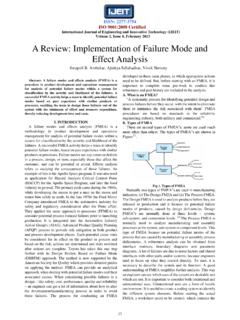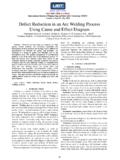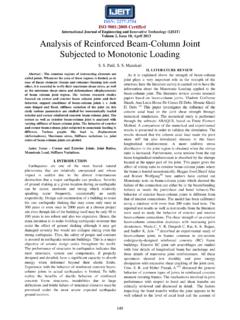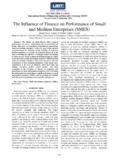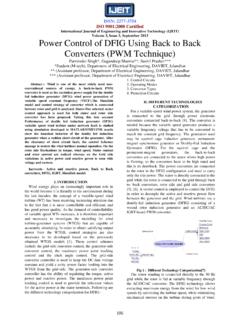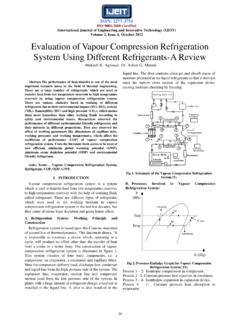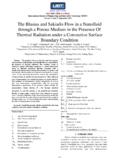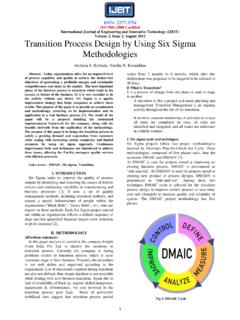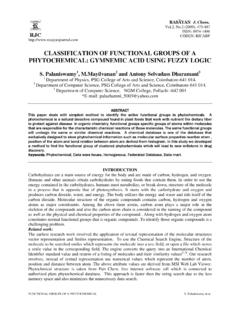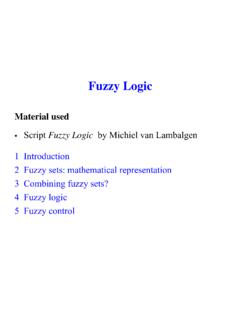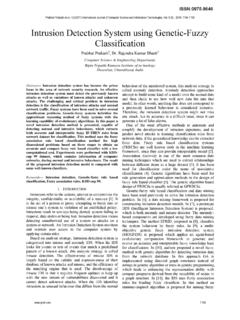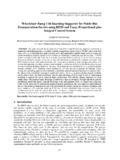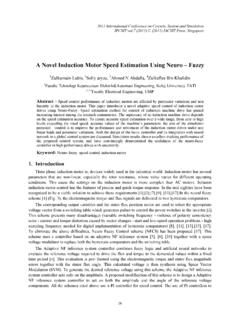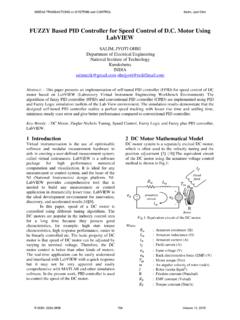Transcription of Artificial Intelligence and its Application in …
1 ISSN: 2277-3754 ISO 9001:2008 Certified International Journal of Engineering and Innovative Technology (IJEIT) Volume 4, Issue 10, April 2015 79 Artificial Intelligence and its Application in Different Areas Avneet Pannu, M. Tech Student Department of Computer Science & Engineering DAV Institute of Engineering and Technology, Jalandhar India Abstract: In the future, intelligent machines will replace or enhance human capabilities in many areas. Artificial Intelligence is the Intelligence exhibited by machines or software. It is the subfield of computer science. Artificial Intelligence is becoming a popular field in computer science as it has enhanced the human life in many areas.
2 Artificial Intelligence in the last two decades has greatly improved performance of the manufacturing and service systems. Study in the area of Artificial Intelligence has given rise to the rapidly growing technology known as expert system. Application areas of Artificial Intelligence is having a huge impact on various fields of life as expert system is widely used these days to solve the complex problems in various areas as science, engineering, business, medicine, weather forecasting. The areas employing the technology of Artificial Intelligence have seen an increase in the quality and efficiency. This paper gives an overview of this technology and the Application areas of this technology.
3 This paper will also explore the current use of Artificial Intelligence technologies in the PSS design to damp the power system oscillations caused by interruptions, in Network Intrusion for protecting computer and communication networks from intruders, in the medical area-medicine, to improve hospital inpatient care, for medical image classification, in the accounting databases to mitigate the problems of it and in the computer games. Keywords: Artificial Intelligence , Intrusion Detection Systems, Neural Networks (computer), Power System Stabilizer. I. INTRODUCTION It is claimed that Artificial Intelligence is playing an increasing role in the research of management science and operational research areas.
4 Intelligence is commonly considered as the ability to collect knowledge and reason about knowledge to solve complex problems. In the near Future intelligent machines will replace human capabilities in many areas. Artificial Intelligence is the study and developments of intelligent machines and software that can reason, learn, gather knowledge, communicate, manipulate and perceive the objects. John McCarthy coined the term in 1956 as branch of computer science concerned with making computers behave like humans. It is the study of the computation that makes it possible to perceive reason and act. Artificial Intelligence is different from psychology because it emphasis on computation and is different from computer science because of its emphasis on perception, reasoning and action.
5 It makes machines smarter and more useful. It works with the help of Artificial neurons ( Artificial neural network) and scientific theorems (if then statements and logics). AI technologies have matured to the point in offering real practical benefits in many of their applications . Major Artificial Intelligence areas are Expert Systems, Natural Language Processing, Speech Understanding, Robotics and Sensory Systems, Computer Vision and Scene Recognition, Intelligent Computer-Aided Instruction, Neural Computing. From these Expert System is a rapidly growing technology which is having a huge impact on various fields of life.
6 The various techniques applied in Artificial Intelligence are Neural Network, Fuzzy Logic, Evolutionary Computing, and Hybrid Artificial Intelligence . Fig 1. Papers published on different Artificial Intelligence Techniques used [10] Artificial Intelligence has the advantages over the natural Intelligence as it is more permanent, consistent, less expensive, has the ease of duplication and dissemination, can be documented and can perform certain tasks much faster and better than the human. The Turing Test Approach: The Turing test was proposed Alan Turing (1950) .This test was designed to test that whether a particular machine can think or not.
7 The test involves a human interrogator who interacts with a human and with a machine and has to tell who is human and which one is machine. The computer passes the test if an interrogator after posing some written questions, cannot tell whether the written response is coming from human or from the machine. II. AREAS OF Artificial Intelligence A. Language understanding: The ability to "understand" and respond to the natural language. To translate from spoken language to a written form and to translate from one natural language to another natural language. Speech Understanding Semantic Information Processing (Computational Linguistics) Question Answering Information Retrieval Language Translation ISSN: 2277-3754 ISO 9001:2008 Certified International Journal of Engineering and Innovative Technology (IJEIT) Volume 4, Issue 10, April 2015 80 B.
8 Learning and adaptive systems: The ability to adapt behavior baged on previous experience, and to develop general rules concerning the world based on such experience. Cybernetics Concept Formation C. Problem solving: Ability to formulate a problem in a suitable representation, to plan for its solution and to know when new information is needed and how to obtain it. Inference (Resolution-Based Theorem Proving, Plausible Inference and Inductive Inference) Interactive Problem Solving Automatic Program Writing Heuristic Search D. Perception (visual): The ability to analyze a sensed scene by relating it to an internal model which represents the perceiving organism's "knowledge of the world.
9 " The result of this analysis is a structured set of relationships between entities in the scene. Pattern Recognition Scene Analysis E. Modeling: The ability to develop an internal representation and set of transformation rules which can be used to predict the behavior and relationship between some set of real-world objects or entities. The Representation Problem for Problem Solving Systems Modeling Natural Systems (Economic, Sociological, Ecological, Biological etc.) Hobot World Modeling (Perceptual and Functional Representations) F. Robots: A combination of most or all of the above abilities with the ability to move over terrain and manipulate objects.
10 Exploration Transportation/Navigation Industrial Automation ( , Process Control, Assembly Tasks, Executive Tasks) Security Other (Agriculture, Fishing, Mining, Sanitation, Construction, etc.) Military Household G. Games: The ability to accept a formal set of rules for games such as Chess, Go, Kalah, Checkers, etc., and to translate these rules into a representation or structure which allows problem-solving and learning abilities to be used in reaching an adequate level of performance. Particular Games (Chess, Go, Bridge, etc.) [11] III. applications OF Artificial Intelligence A. Application of Artificial Intelligent Techniques in Power system stabilizers (PSSs) Design Since the 1960s, PSSs have been used to add damping to electromechanical oscillations.
